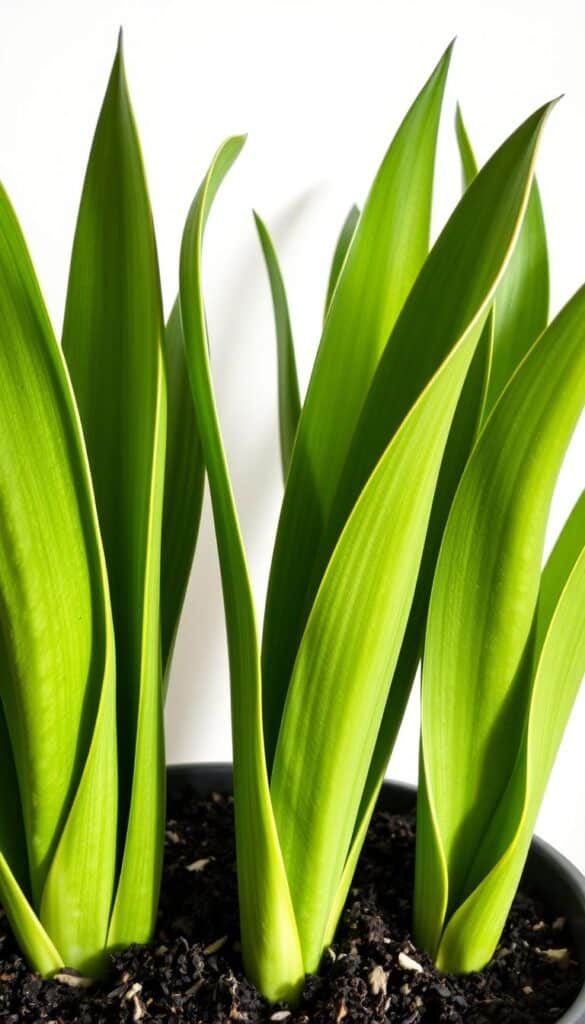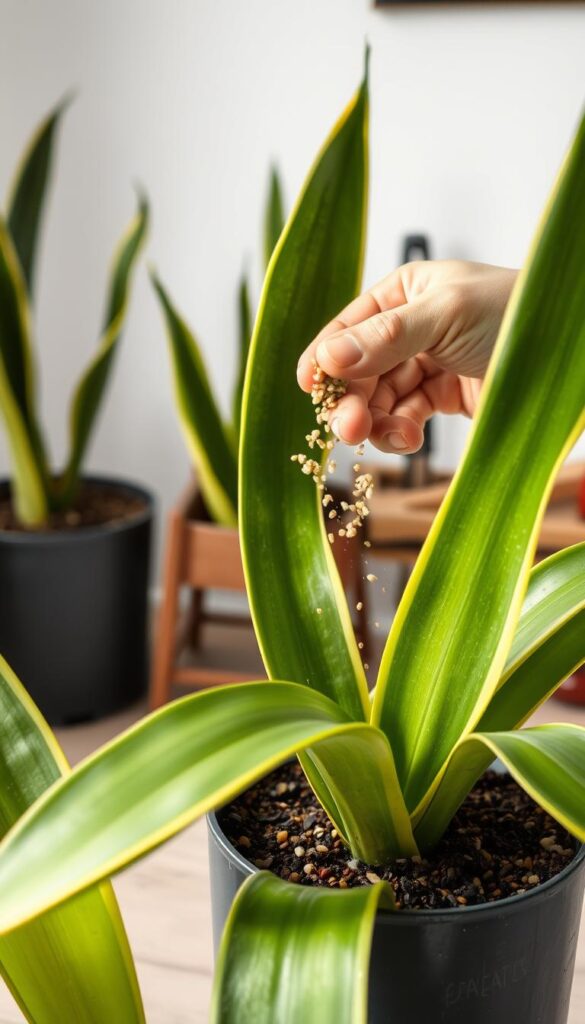I still remember the first time I brought a snake plant into my home. I was amazed by its striking leaves and the fact that it could thrive in low-light conditions. What I didn’t know then was how much this plant would teach me about resilience and the joy of low-maintenance gardening.
Snake plants, also known as Mother-in-Law’s Tongue, are incredibly hardy. They can survive with minimal water and flourish in almost any lighting setup. This makes them a perfect choice for busy people or those new to houseplants. Plus, they’re great air purifiers, releasing oxygen at night while you sleep.
One of the key things I’ve learned is that overwatering is a common mistake. Snake plants prefer their soil to dry out between waterings. Choosing the right pot is also essential—make sure it has good drainage holes to prevent root rot. These simple tips have helped me keep my snake plant healthy and vibrant.
Understanding Your Snake Plant
Snake plants are known for their striking, upright leaves that resemble swords. These leaves often feature beautiful variegated patterns in shades of green, yellow, and cream. Their stiff, sword-like structure gives them a unique appearance that adds elegance to any room.
One of the fascinating aspects of snake plants is their variety. Popular cultivars include Dracaena trifasciata ‘Laurentii’ and ‘Hahnii’. Each variety boasts distinct characteristics, such as size, leaf shape, and color patterns. This diversity allows you to choose the perfect plant that fits your home decor and personal style.
What makes snake plants even more appealing is their ability to thrive in low-light environments. This makes them an ideal choice for rooms with limited natural light. Their low-maintenance needs also make them perfect for busy individuals or those new to houseplants.
| Variety | Leaf Characteristics | Growth Habit | Lighting Preference |
|---|---|---|---|
| Dracaena trifasciata ‘Laurentii’ | Yellow edges with green centers | Upright, sword-shaped | Low to medium light |
| Dracaena trifasciata ‘Hahnii’ | Dark green with yellow stripes | Compact, rosette-forming | Tolerates low light |
| Dracaena trifasciata ‘Moonshine’ | Silvery-gray with dark green borders | Upright, narrow leaves | Medium to bright light |
Understanding these botanical details is the first step in providing the best care for your snake plant. By recognizing the specific needs of your variety, you can create an environment that supports its health and beauty.
Ideal Growth Conditions for Snake Plants
Creating the perfect environment for your snake plant is key to its success. These plants thrive in bright, indirect light but can tolerate low-light conditions. However, direct sunlight can scorch their leaves, so balance is essential.
Lighting and Temperature Requirements
Snake plants prefer 8-10 hours of indirect sunlight daily. Morning direct sun is beneficial, but avoid harsh afternoon rays. They love warm temperatures between 65-75°F, away from cold drafts.
Humidity and Seasonal Considerations
These plants prefer dry environments with humidity below 50%. In summer, water sparingly, allowing soil to dry between sessions. In winter, reduce watering to once a month. Adjusting care seasonally ensures optimal health.
| Lighting Needs | Temperature Range | Humidity Levels |
|---|---|---|
| 8-10 hours indirect sun | 65-75°F | Below 50% |
By tailoring your home to these conditions, your snake plant will flourish, bringing elegance and freshness to your space.
How to take care of a snake plant: Watering and Soil Care
Proper watering and soil care are vital for keeping your Dracaena trifasciata healthy. Overwatering is a common mistake that can lead to root rot, so it’s essential to water only when the soil is completely dry. This ensures your plant stays thriving and avoids potential issues.
Effective Watering Techniques
Water your snake plant deeply when the soil feels dry to the touch. During the growing season, usually once a week is sufficient, but this can vary. In winter, reduce watering to once a month to match the plant’s slower growth. Always check the soil moisture by sticking your finger into the soil up to the first knuckle. If it’s dry, it’s time to water; if not, wait another day or two before checking again.
Choosing the Right Potting Soil Mix
Use a fast-draining potting mix, such as a cactus or succulent blend, to keep the soil from retaining too much water. This helps prevent root rot and ensures healthy growth. Make sure your pot has drainage holes to allow excess water to escape. If your pot doesn’t have a drainage hole, consider repotting it into one that does. Proper drainage is key to maintaining your plant’s health.

Repotting and Propagation Techniques
Repotting and propagating snake plants can seem daunting, but with the right approach, it’s a breeze. These techniques not only help maintain your plant’s health but also allow you to share these beautiful dracaena varieties with friends and family.
When and How to Repot
Your dracaena will need repotting when it becomes root-bound. Look for signs like roots appearing at the drainage holes or the soil drying out too quickly. Spring is the ideal time for this process.
- Choose a container slightly larger than the current one with good drainage.
- Gently remove the plant, taking care not to damage the roots.
- Place it at the same depth as before, ensuring the base of the leaves is above the soil.
This ensures your plant continues to thrive in its new home.
Propagating Through Division and Leaf Cuttings
Propagation is a great way to share your plant. Division involves separating the rhizome, while leaf cuttings can be planted directly in well-draining soil. Keep the soil moist but not soggy to prevent root rot.
- For division, cut the rhizome with a sharp tool and plant each section.
- For leaf cuttings, let them dry for a day to form a callus before planting.
By following these steps, you can enjoy the beauty of your snake plant for years to come and share its benefits with others.
Fertilizing, Pruning, and Maintenance Tips
Maintaining a vibrant and healthy garden indoors with snake plants requires attention to fertilizing, pruning, and regular maintenance. These practices ensure your plant remains lush and thrives in its environment.
Best Practices for Fertilization & Pruning
Fertilizing your snake plant should be done cautiously to avoid damaging the roots. I recommend fertilizing once in the spring and again in mid-summer using a balanced, diluted slow-release fertilizer. This approach provides essential nutrients without causing salt buildup, which can harm the plant. Always dilute the fertilizer to half the recommended strength to prevent root damage.
Pruning is another crucial aspect of snake plant care. It helps maintain the plant’s appearance and promotes healthy growth. Remove any damaged or overly tall leaves to encourage new shoots. Use clean, sharp tools to prevent spreading infections. Pruning also helps control the plant’s height, keeping it visually appealing in your room.
| Fertilizing Tips | Pruning Tips | Maintenance Tips |
|---|---|---|
| Fertilize in spring and mid-summer | Remove damaged or tall leaves | Dust leaves regularly |
| Use diluted, slow-release fertilizer | Use clean, sharp tools | Check soil moisture before watering |
Regular maintenance tasks, like dusting the leaves, contribute significantly to the plant’s health. Dust can block light absorption, so gently wipe the leaves with a damp cloth. This simple step ensures your snake plant continues to photosynthesize efficiently.
Creating a garden-like atmosphere indoors with snake plants is easy. Place them in well-ventilated areas to enhance air quality. In the summer, ensure your snake plant is in a cool, shaded room to prevent leaf scorch. With these practices, your snake plant will remain a stunning addition to your indoor garden.

Troubleshooting Common Snake Plant Issues
Even the hardiest plants can run into problems. For my trifasciata, common issues like overwatering and pests have taught me valuable lessons. Let’s explore how to identify and fix these problems.
Identifying Overwatering and Root Rot
Overwatering is a common mistake that can lead to root rot. If you notice yellow, mushy leaves or a foul smell from the soil, your plant may be suffering. To revive it, carefully remove it from the pot, trim any rotting roots with sterile tools, and repot it in fresh, well-draining soil. This method has worked wonders for my trifasciata.
Managing Pests and Leaf Damage
Pests like spider mites and mealybugs can harm your plant. If you spot any, treat the plant with neem oil or insecticidal soap. Isolate it to prevent the infestation from spreading. Regular inspection is key to maintaining your trifasciata’s health indoors.
| Issue | Symptoms | Solution |
|---|---|---|
| Overwatering | Yellow, mushy leaves; foul odor | Trim rotting roots; repot in fresh soil |
| Pests | White, cottony patches; tiny moving dots | Apply neem oil or insecticidal soap |
Consistency is key. Every week, check your plant’s condition and adjust your care routine as needed. With attention and the right techniques, your trifasciata will thrive indoors under indirect sunlight.
Styling Your Snake Plant in the Home
Snake plants bring a touch of modern elegance to any room. Their architectural leaves and versatile sizes make them perfect for various home settings. I love how they can brighten up a cozy living room or add a professional vibe to a modern office.
Finding the Perfect Spot in Your Home
When placing your snake plant, choose spots with plenty of indirect sunlight. Direct sun can burn the leaves, so morning light is ideal. I’ve found that areas near north-facing windows work well. Avoid placing them in overly humid spots to prevent rot and maintain the right humidity levels.
Enhancing Décor with Snake Plant Displays
Snake plants are versatile in design. Use them as focal points in minimalist spaces or mix them with other plants for a lush look. Repotting every few years keeps them fresh. I also like to style mine in modern pots that match my home’s aesthetic.
- Place plants in areas with indirect sunlight to avoid leaf scorch.
- Repot every 2-3 years to refresh the soil and pot.
- Check soil weekly to ensure it’s dry before watering.
With these tips, your snake plant will not only thrive but also enhance your home’s beauty. Their low-maintenance needs make them a stylish and practical choice for any space.
Wrapping Up Your Snake Plant Journey
As I reflect on my journey with snake plants, I’m reminded of how these resilient plants have transformed my space. Their ability to thrive in various locations, from low-light corners to bright rooms, makes them a versatile choice for any home.
Throughout this guide, I’ve shared practical tips on watering, lighting, and repotting. These strategies are simple yet effective, ensuring your plant remains vibrant year-round. Even during winter, when growth slows, consistent care practices keep your snake plant healthy.
By adapting your approach to your plant’s needs and location, you can enjoy its benefits. Whether it’s purifying the air or adding a touch of elegance, your snake plant will flourish with the right attention.
Remember, consistency is key, especially during winter. With these techniques, you’ll gain confidence in your ability to nurture a thriving snake plant. Happy planting!
